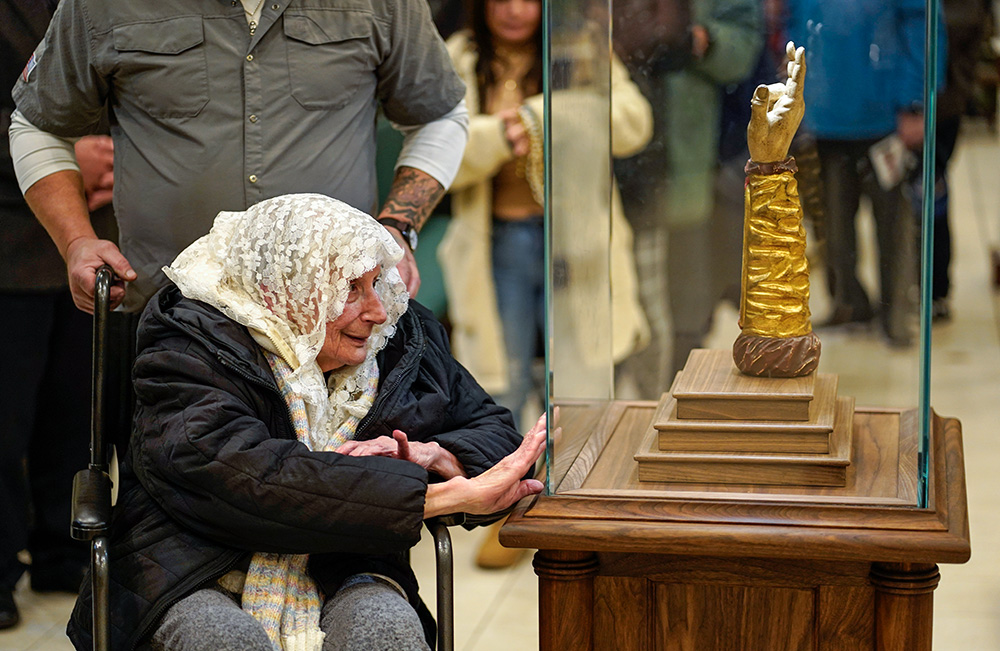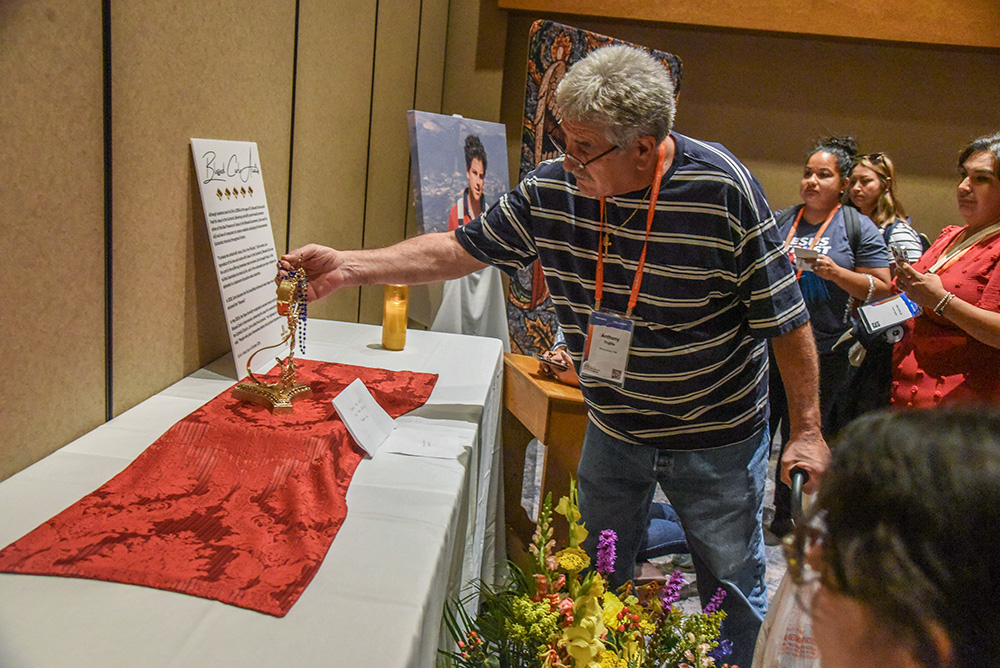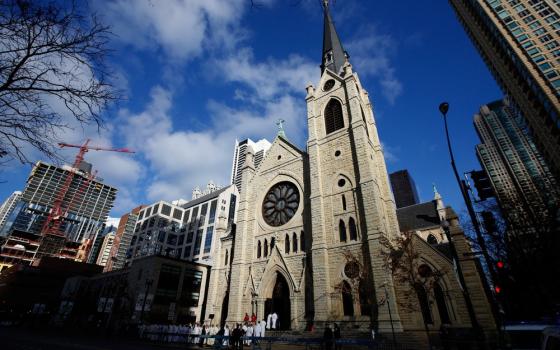
A woman presses her hand against a glass case protecting a reliquary containing a bone from the arm of St. Jude the Apostle at St. Jude Church in Mastic Beach, N.Y., Nov. 27, 2023. The relic, which arrived in Chicago from Italy in September,was on a nine-month tour of the U.S. (OSV News/Gregory A. Shemitz)
Pope Francis announced the canonization of Blessed Carlo Acutis, the first millennial saint, will take place during the Jubilee for Adolescents, April 25-27, 2025. The pope also announced a simplified ritual for the papal funerals.
When Acutis' body was placed on display in Assisi, Italy, where he is buried, people asked if his body was incorrupt. Dressed in jeans and sneakers, his features appear remarkably lifelike, but that is a wax covering. Underneath, his flesh has gone the way of all flesh. The same technique is often used when saints' bodies are put on display, such as that of St. Padre Pio.
Popes hold such an exalted position, it seemed natural that their funerals would turn into elaborate affairs. On YouTube, you can find videos of papal funerals going back to that of Pope Pius XI in 1939. The bodies were laid out on a catafalque but not in a coffin, so the faithful could view it. If the pope died at the Vatican, the body was carried in the same coffinless manner through the piazza in front of St. Peter's, a tradition that was followed through the funeral of Pope John Paul II in 2005. The pope's corpse was only placed in a coffin shortly before the funeral Mass.
This insistence on showing the body of the deceased pontiff even survived the dreadful events surrounding the death of Pope Pius XII. His personal doctor botched the embalming, the pope's chest exploded on the drive from Castel Gandolfo, emitting a sound like firecrackers; the stench was so bad that the Swiss Guards standing beside the catafalque had to be changed every 15 minutes; the poor man's fingers and nose fell off.
What is it with us Catholics and dead bodies?
Two dogmas of our faith account for what must seem like a ghoulish fascination to non-Catholics.
Advertisement
The first is our belief in the Incarnation. Our veneration of relics, our placement of candles at the statues of saints, even our habit of praying at a shrine rather than just while walking through the garden, all of these Catholic devotional characteristics attest to our belief that heaven can come down to earth. We believe Christ's holiness, evident in the lives of his most faithful followers, the saints, can reach us in a particular place, in the particularity of our lives.
When you visit a country with a Catholic culture, one of the first indications is the omnipresence of shrines along the streets, little statues or mosaics with a saint's image. In Old San Juan, Puerto Rico, or Seville, Spain, or most towns in Italy, there is religious iconography everywhere. In Rome, you can't walk three blocks without finding another church. The faith permeates the physical landscape of the culture. Christ walked the earth 2,000 years ago. We want him still to be walking the earth.
The second dogma is ecclesiological: The church is the body of Christ. The metaphor started with St. Paul who, in his First Letter to the Corinthians, Chapter 12, employs the image to explain the diversity of gifts given by the Spirit. And it worked. That chapter is a wonderful explanation of how the Spirit gives each of us a role in the life of the church, but that these gifts build up the unity of the Church. "Now you are the body of Christ, and each one of you is a part of it" (1 Cor 12:27).
We are Christ's body on earth, but we know that this body is also in heaven, it reaches across what is otherwise an abyss no one can cross. For Christians, death is a door, not a wall. The bonds extend beyond the grave. We Catholics here on earth pray for, and to, and with, the Catholics who have gone on.
This belief was a source of great controversy at the time of the Reformation, when abuses of this belief caused many reformers to repudiate the veneration of relics and forswear the practice of venerating the bodies of the saints.

Anthony Trujillo of Albuquerque, N.M., places a rosary against a reliquary holding a relic of Blessed Carlo Acutis July 19, 2024, in the relic chapel of the National Eucharistic Congress at the Indiana Convention Center in Indianapolis. (OSV News/The Criterion/Sean Gallagher)
The abuses needed reform, but the reformers threw the baby out with the baptismal water. We shouldn't be raising money off relics, but if touching them, or even being close to the bodies of the saints, help us feel a closeness with those who have gone to heaven, that is a good thing.
The pope's decision to simplify his own and future pontiff's funeral rites brings to mind the practice of burying Habsburg royalty in the crypt of the Capuchin church in Vienna. A court official knocks at the door to the crypt, and one of the Capuchin priests asks who is there. The official lists the titles of the deceased, to which a Capuchin priest replies, "We do not know him."
A second time, the official knocks and is asked the same question. He replies with a similar list of the deceased's personal accomplishments and the Capuchin again says, "We do not know him."
The third time, the official knocks and when asked who desires entry, replies with the deceased's given name followed by "a mortal and a sinner." The Capuchin father replies, "Then let him come in." The door is opened.
This is why we want to be close to the saints and to the bodies of our dead popes: We are sinners who want to be close to holiness. Our belief in the Incarnation and that the church is the body of Christ are twin dogmas that express themselves in these simple acts of bodily veneration. Popular piety often reveals the truths of our faith as profoundly as any theological treatise.







